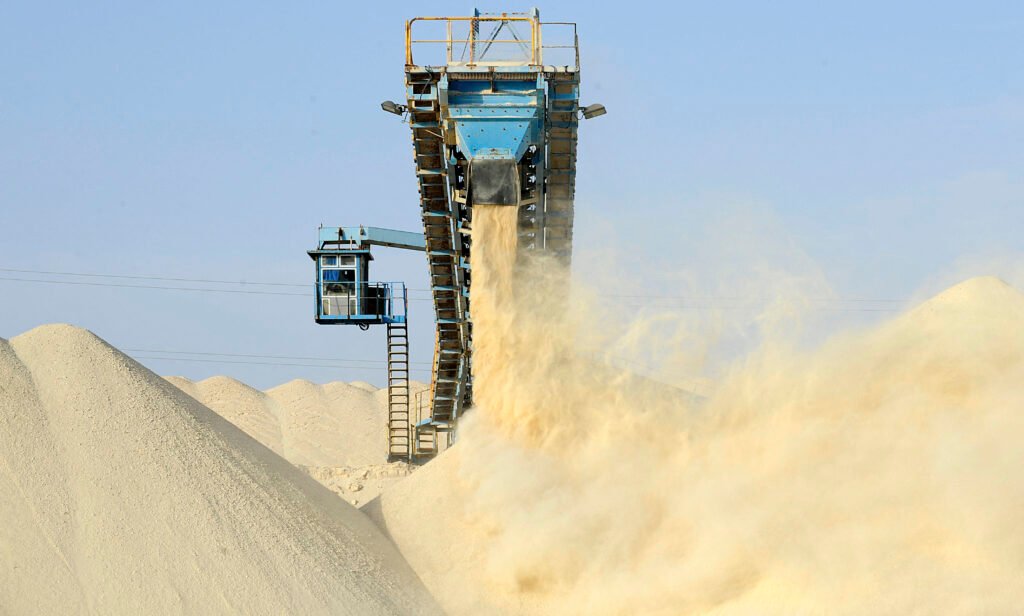
Imagine standing on the edge of a vast open-pit mine, the air thick with the scent of earth and machinery, as massive trucks haul tons of phosphate rock from the depths of Morocco’s sun-scorched landscape. This isn’t just any mine—it’s part of Morocco’s colossal phosphate industry, a cornerstone of the nation’s economy and a critical player in global food security. As the world’s leading exporter of phosphate, Morocco holds a staggering 75% of the planet’s reserves, making it a linchpin in the production of fertilizers that feed billions. But what does this mean for Morocco, its people, and the world? Let’s embark on a journey through the dusty mines, economic triumphs, environmental challenges, and future prospects of phosphate mining in Morocco.
The Backbone of Morocco’s Economy
Phosphate mining isn’t just a job in Morocco; it’s a way of life that powers the nation’s economy. In 2022, the Office Chérifien des Phosphates (OCP), Morocco’s state-owned phosphate giant, reported a record-breaking revenue of 131 billion dirhams (approximately $12 billion), a figure that underscores the industry’s dominance. Phosphates and their derivatives account for roughly 20% of Morocco’s export value and 10% of its GDP, with 90% of this coming from phosphate-related products. The industry employs around 40,000 people, both directly and indirectly, providing livelihoods in regions like Khouribga, Youssoufia, and Benguérir, where mining is the heartbeat of local communities.
But it’s not just about numbers. Picture a small town like Youssoufia, where the rhythm of daily life syncs with the hum of mining operations. Families depend on the wages earned in the mines, and local businesses thrive on the economic ripple effect. Yet, the wealth generated often contrasts with the dusty reality of these towns, where environmental concerns linger like an uninvited guest. The story of Morocco’s phosphate industry is one of triumph and tension, a tale of economic might intertwined with social and ecological complexities.
A Geological Goldmine: Morocco’s Phosphate Reserves
Morocco’s phosphate reserves are nothing short of a geological marvel. The country, along with the disputed territory of Western Sahara, holds an estimated 50 billion metric tons of phosphate rock, dwarfing other nations’ reserves. For context, Egypt, the next largest holder, has just 2.8 billion metric tons. This vast resource is concentrated in four main mining centers: Khouribga, Youssoufia, Benguérir, and Boucraa. In 2020, Morocco extracted nearly 41 million metric tons of phosphate, with Khouribga alone accounting for 31 million metric tons, according to Statista.
Why is phosphate so valuable? It’s the backbone of phosphorus, a key nutrient in fertilizers that drives global agriculture. Without it, crops like wheat, rice, and corn would struggle, threatening food security for billions. Morocco’s high-grade phosphate rock, rich in phosphorus pentoxide (P2O5), commands a premium on the global market because it requires less processing to produce phosphoric acid, a critical component in fertilizers. As CRU Group notes, Morocco’s dominance allows it to influence global phosphate prices, especially when supply chains are disrupted, as seen during the Russia-Ukraine conflict in 2022.
The Mining Process: From Rock to Riches
Let’s take a closer look at how phosphate gets from the ground to the global market. The process begins in massive open-pit mines, where layers of overburden—soil and rock covering the phosphate—are stripped away using draglines and bulldozers. At Benguérir, for example, Mining Technology describes how six benches of phosphate are drilled, blasted, and loaded into trucks for transport to primary crushers. The rock is then screened, washed, and processed into marketable products like phosphoric acid or fertilizers at coastal plants in Safi and Jorf Lasfar.
The scale is staggering. Picture a 98.3-kilometer conveyor belt—the world’s longest—hauling phosphate from the Boucraa mine in Western Sahara to the port of El Aaiún. This engineering feat, operated by OCP’s subsidiary Phosboucraa, symbolizes the industry’s ambition. But it’s not without controversy. The Boucraa mine, located in a disputed territory, has drawn criticism from groups like Western Sahara Resource Watch, who argue that Morocco’s extraction of phosphate from Western Sahara violates international law and deprives the Sahrawi people of their resources.
Economic Impact: A Double-Edged Sword
The economic benefits of phosphate mining are undeniable. In 2023, phosphate exports grew by 12.3% year-on-year, reaching $3 billion from January to April, according to posts on X. OCP’s strategic investments, like the $12 billion “green investment program” to transition to renewable energy, aim to sustain this growth while reducing the industry’s environmental footprint. The company’s pivot toward producing triple superphosphate (TSP) at Jorf Lasfar reflects a forward-thinking approach to meet global demand for phosphorus-rich fertilizers, as highlighted by CRU Group.
Yet, the wealth doesn’t always trickle down. In mining towns like Imider, local communities have protested against environmental degradation and limited job opportunities. A Bard CEP Eco Reader article recounts how Berber villagers in Imider camped on Mount Alebban for nine years, demanding that the silver mine operated by Société Metallurgique d’Imider (SMI) stop polluting their waterways with cyanide and mercury. Similar concerns surround phosphate mining, where toxic byproducts like cadmium and uranium raise health risks for workers and residents. The paradox is stark: Morocco’s phosphate wealth fuels global agriculture, but local communities often bear the environmental and social costs.
Environmental Challenges: The Hidden Cost of Phosphate
Phosphate mining is a messy business. The process generates massive piles of waste, known as phosphogypsum, which can contain heavy metals and radioactive elements like uranium. In Morocco, this waste is often dumped into the Atlantic Ocean, raising concerns about marine pollution. A 2006 study by Morocco’s national fisheries research institute, cited in The Guardian, found significant cadmium contamination in shellfish near OCP’s discharge points. Residents in mining towns like Youssoufia report health issues, from respiratory problems to cancer, linked to dust and chemical exposure.
OCP has taken steps to address these concerns. Since 2013, the company has rehabilitated 3,870 hectares of mined land, planting 4.5 million trees, including olive and argan, to restore ecosystems, according to Frontiers. Their “Green Mine” project in Khouribga, backed by a $152 million investment, aims to transform old mining sites into sustainable agricultural land. But critics argue that these efforts fall short. The sheer scale of mining—36 million tons of phosphate rock produced in 2019 alone, per the USGS—makes environmental management a Herculean task.
Global Implications: Feeding the World or Fueling Conflict?
Morocco’s phosphate dominance has far-reaching implications. With 75% of global reserves, the country is a gatekeeper of food security, as phosphorus is irreplaceable in modern agriculture. CNBC notes that fertilizers, powered by phosphate, account for 50% of global food production. OCP’s efforts to boost soil fertility in Africa, through initiatives like soil testing labs at Mohammed VI Polytechnic University, aim to combat hunger, particularly in sub-Saharan Africa, where 21% of people face severe food insecurity.
However, the industry’s reliance on Western Sahara’s Boucraa mine complicates the picture. In 2019, exports from this mine dropped to 1.03 million tonnes, the lowest since 2012, due to declining North American demand and international pressure, according to Forbes. The Sahrawi people argue that Morocco’s operations in the disputed territory are exploitative, a sentiment echoed by the United Nations and advocacy groups. The conflict underscores a broader question: can Morocco balance its economic ambitions with ethical and geopolitical responsibilities?
Comparison Table: Morocco’s Phosphate Mining Centers
Key Statistics of Morocco’s Phosphate Mining Centers (2020-2022)
| Mining Center | Extraction (2020, million metric tons) | Marketed Production (2022, million metric tons) | Key Features |
|---|---|---|---|
| Khouribga | 31.0 | 23.0 | Largest phosphate mine globally, high-grade rock, advanced processing facilities |
| Youssoufia | 6.5 | 5.0 | Significant waste management challenges, community health concerns |
| Benguérir | 3.1 | 2.5 | Newest mining center, focus on sustainable rehabilitation |
| Boucraa | 2.6 | 1.5 | Located in Western Sahara, controversial due to geopolitical disputes |
Data sourced from Statista and Mining Technology.
This table highlights the scale and diversity of Morocco’s phosphate operations, with Khouribga leading in output and Boucraa facing unique political challenges. Each center plays a distinct role in Morocco’s phosphate empire, but their environmental and social impacts vary widely.
The Future of Phosphate Mining in Morocco
Morocco’s phosphate industry is at a crossroads. The government’s 2025-2030 mining development plan aims to boost non-phosphate mining revenue to $1.7 billion by 2030, diversifying into strategic metals like cobalt and copper, according to Reuters. Yet, phosphate remains the crown jewel. OCP’s investments in renewable energy, such as solar-powered mining facilities and green hydrogen projects, signal a commitment to sustainability. The company’s goal to achieve carbon neutrality by 2027 could set a global standard for eco-friendly mining.
On the flip side, the industry faces mounting pressure to address environmental and social issues. Strengthening regulatory frameworks, as suggested by Frontiers, could ensure better land rehabilitation and pollution control. Community engagement is also critical. Initiatives like OCP’s partnerships with African nations to improve soil fertility show promise, but local voices in mining towns must be heard to avoid repeating past mistakes.
FAQ: Common Questions About Phosphate Mining in Morocco
Q: Why is Morocco so important in the global phosphate market?
A: Morocco holds 75% of the world’s phosphate reserves and is the leading exporter, producing high-grade rock that’s critical for fertilizers. Its dominance gives it significant influence over global food security.
Q: What are the environmental impacts of phosphate mining?
A: Mining generates phosphogypsum waste, which can contain heavy metals like cadmium and uranium, polluting water and air. OCP is working on rehabilitation, but challenges like marine contamination persist.
Q: How does phosphate mining affect local communities?
A: It provides jobs and economic growth but also health risks from dust and chemical exposure. Communities in places like Imider have protested for better environmental protections and job opportunities.
Q: What’s the controversy surrounding Western Sahara?
A: The Boucraa mine in Western Sahara, operated by OCP, is in a disputed territory. Critics argue that Morocco’s extraction violates international law, depriving the Sahrawi people of their resources.
Q: How is Morocco addressing sustainability in phosphate mining?
A: OCP’s “Green Mine” project and renewable energy initiatives aim to reduce environmental impact. The company has rehabilitated thousands of hectares and plans to achieve carbon neutrality by 2027.
Conclusion: Balancing Wealth, Responsibility, and Sustainability
Morocco’s phosphate industry is a paradox—a source of immense wealth and global influence, yet a lightning rod for environmental and geopolitical controversy. From the sprawling mines of Khouribga to the contentious operations in Western Sahara, the story of phosphate mining is one of ambition, innovation, and unresolved challenges. As I reflect on the dusty landscapes and the people whose lives are shaped by these mines, I’m struck by the delicate balance Morocco must strike. The nation has the power to feed the world, but it must also protect its land and people.
For readers, the takeaway is clear: phosphate mining is more than an industry—it’s a global lifeline with local consequences. If you’re curious to learn more, explore OCP’s sustainability initiatives on their official website or dive into the geopolitical complexities via Western Sahara Resource Watch. For those in the mining or agricultural sectors, consider how Morocco’s innovations in sustainable mining could inspire your work. And for everyone else, next time you bite into a piece of bread or enjoy a fresh salad, remember the invisible role Morocco’s phosphate plays in bringing that food to your table. What steps can we, as global citizens, take to support ethical and sustainable resource extraction? The answer lies in staying informed, advocating for transparency, and supporting policies that prioritize both people and the planet.
